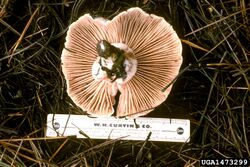Biology:Hygrophorus purpurascens
| Hygrophorus purpurascens | |
|---|---|

| |
| Scientific classification | |
| Domain: | Eukaryota |
| Kingdom: | Fungi |
| Division: | Basidiomycota |
| Class: | Agaricomycetes |
| Order: | Agaricales |
| Family: | Hygrophoraceae |
| Genus: | Hygrophorus |
| Species: | H. purpurascens
|
| Binomial name | |
| Hygrophorus purpurascens | |
| Synonyms[2] | |
|
Agaricus purpurascens Alb. & Schwein. (1805) | |
Hygrophorus purpurascens, commonly known as the purple-red waxy cap,[3] is a species of agaric fungus in the family Hygrophoraceae. Its cap has a pink background color with streaks of purplish red overlaid, and mature gills have red spots.
Taxonomy
The species was originally described as Agaricus purpurascens by Johannes Baptista von Albertini and Lewis David de Schweinitz in 1805.[4] Elias Fries transferred it to the genus Hygrophorus in 1838. Paul Kummer's 1871 Limacium purpurascens is a synonym. The specific epithet purpurascens means "becoming purple". It is commonly known as the "veiled purple hygrophorus".[5]
Description
The cap is convex to flattened, measuring 6–15 cm (2.4–5.9 in) in diameter. The color is pinkish red in the center to white, often irregularly tinged with pink. The flesh is white. The gills have a decurrent attachment to the stipe and are white to pale pink spotted with pinkish or purplish red. The stipe measures 3–10 cm (1.2–3.9 in) long by 1–2.4 cm (0.4–0.9 in) wide, and is more or less the same color as the cap, often spotted with dark red.[6] Fruit bodies are edible.[7]
The spore print is white. Spores are thin-walled, elliptical, smooth, and measure 5.5–8 by 3–4.5 µm. The basidia (spore-bearing cells) are narrowly club-shaped, thin-walled, four-spored, and measure 40–56 by 5–8 µm.[6]
Hygrophorus russula is similar in appearance to H. purpurascens, but the former species can be distinguished by its tendency to bruise yellow, and its association with hardwood trees.[8]
Habitat and distribution
The fruit bodies of Hygrophorus purpurascens grow on the ground in clusters or groups under conifer trees.[9] A snowbank mushroom, it is commonly found fruiting near the edges of snowbanks, or shortly after snowmelt.[10]
See also
- List of Hygrophorus species
References
- ↑ Kummer P. (1871) (in German). Der Führer in die Pilzkunde. Zerbst: C. Luppe. p. 118.
- ↑ "Hygrophorus purpurascens (Alb. & Schwein.) Fr. 1838". MycoBank. International Mycological Association. http://www.mycobank.org/MycoTaxo.aspx?Link=T&Rec=182721.
- ↑ Thiers, Harry D.; Arora, David (September 1980). "Mushrooms Demystified". Mycologia 72 (5): 1054. doi:10.2307/3759750. ISSN 0027-5514. http://dx.doi.org/10.2307/3759750.
- ↑ (in Latin) Conspectus Fungorum in Lusatiae superioris. Leipzig: Kummer. 1805. p. 182. https://archive.org/details/conspectusfungo00persgoog.
- ↑ Roody WC. (2003). Mushrooms of West Virginia and the Central Appalachians. Lexington, Kentucky: University Press of Kentucky. p. 143. ISBN 0-8131-9039-8. https://books.google.com/books?id=5HGMPEiy4ykC&pg=PA143.
- ↑ 6.0 6.1 Mushrooms of North America in Color: A Field Guide Companion to Seldom-Illustrated Fungi. Syracuse, New York: Syracuse University Press. 1995. pp. 52–3. ISBN 0-8156-2666-5.
- ↑ Boa E. (2004). Wild Edible Fungi: A Global Overview of Their Use and Importance to People (Non-Wood Forest Products). Food & Agriculture Organization of the UN. p. 135. ISBN 92-5-105157-7. https://books.google.com/books?id=Zd2NlcNZgvcC&pg=PA135.
- ↑ Kuo M. (2007). 100 Edible Mushrooms. Ann Arbor, Michigan: The University of Michigan Press. p. 266. ISBN 978-0-472-03126-9. https://archive.org/details/100ediblemushroo00kuom/page/266.
- ↑ Mushrooms of Northeastern North America. Syracuse, New York: Syracuse University Press. 1997. p. 144. ISBN 978-0815603887. https://books.google.com/books?id=T2uU12XcRD4C&pg=PA144.
- ↑ Arora D. (1986). Mushrooms Demystified: A Comprehensive Guide to the Fleshy Fungi. Berkeley, California: Ten Speed Press. p. 46. ISBN 0-89815-169-4. https://archive.org/details/mushroomsdemysti00aror_0/page/46.
External links
Wikidata ☰ Q76836 entry
 |

